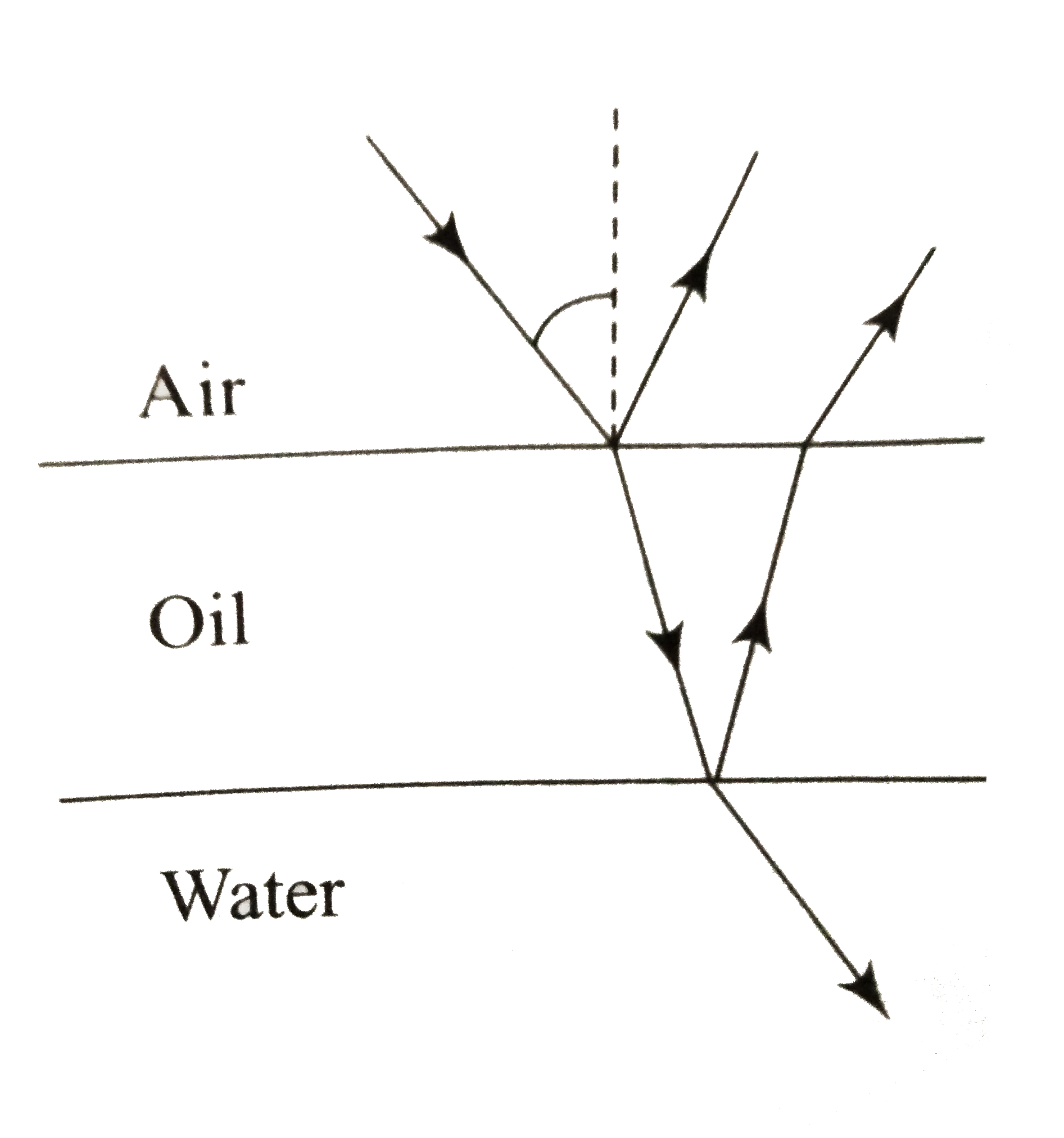An oil film (n=1.45) floating on water is illuminated by white light at normal incidence. The film is 280 nm thick. Find (a) the color or the light in the visible specturm most strongly reflected and (b) the color of the light in the specturm most strongly transmitted. Explain your reasoning.
The light reflected from the top of the oil film undergoes phase reversal. Since 1.45>1.33, the light reflected from the bottom undergoes no reversal. For constructive interference of reflected light, we then have
2nt=(m+12)λ
or λm=2ntm+12=2(1.45)(280nm)m+12
substituting for m gives:
m=0,λ0=1620nm (infrared)
m=1,λ1=54nm (green)
m=2λ2=325nm (ultraviolet)
Both infrared and ultraviolet lights are invisible to the human eye, so the dominant color in reflected light is green.
b. The dominant wavelengths in the transmitted light are those that produce destuctive interference in the reflected light The condition for destructive interference upon reflection is
2nt=mλ
or λm=2ntm=812nmm
substituting for m gives
m=1,λ1=812nm (near infrared)
m=2,λ2=406nm (violet)
m=3,λ3=271nm (ultraviolet)
Of these, the only wavelength visible to the human eye (and hence the dominant wavelength observed in hte transmitted light) is 406 nm. Thus, the dominant color in the transimitted light is violet.

Topper's Solved these Questions
- WAVE OPTICSBOOK - CENGAGE PHYSICSCHAPTER - WAVE OPTICSEXERCISE - Exercise 2.2
22 Videos
- WAVE OPTICSBOOK - CENGAGE PHYSICSCHAPTER - WAVE OPTICSEXERCISE - Subjective
11 Videos
- WAVE OPTICSBOOK - CENGAGE PHYSICSCHAPTER - WAVE OPTICSEXERCISE - Solved Examples
10 Videos
- THERMODYNAMICSBOOK - CENGAGE PHYSICSCHAPTER - THERMODYNAMICSEXERCISE - QUESTION BANK
34 Videos
- WAVESBOOK - CENGAGE PHYSICSCHAPTER - WAVESEXERCISE - QUESTION BANK
38 Videos
Similar Questions
Oil floating on water looks cloured due to interference of light. What should be the approximate thickness of the film for such effects to be visible ?
View SolutionA parallel beam of white light is incident normally on a water film1.0x10−4 cm thick. Find the wavelength in the visible range (400 nm-700 nm) which are strongly transmitted by the film Refractive index of water = 1.33.
View Solution
Knowledge Check
When white light is incident normally an oil film of thickness 10−4cm and refractive index. 1.4 then the wavelength which will not be seen in the reflected system of light is
A7000AB5600AC4000ADAll of theseA thin film of refractive index 1.5 and thickness 4×10−5 cm is illuminated by light normal to the surface. What wavelength within the visible spectrum will be intensified in the reflected beam?
A4800ÅB5800ÅC6000ÅD6800ÅA 4.0×102 nm thick film of kerosene (n = 1.2) is floating on water. White light is normally incident on the film. What is the visible wavelength in air that has a maximum intensity after the light is reflected?
Note: The visible wavelength range is 380 nm to 750 nm.A380 nmB480 nmC430 nmD530 nm
A thin film of thickness 4×10−5 cm and μ=1.5 is iluminated by white light incident normal to its surface. What wavelength in the visible range be intensified in the reflected beam ?
View SolutionA glass plate (n=1.53) that is 0.485 μ m thick and surrounded by air is illuminated by a beam of white light normal to the plate.
(a) What wavelengths (in air) within the limits of the visible spectrum (λ=400to700nm) are intensified in the reflected beam ?
(b) What wavelengths within the visible spectrum are intensified in the transmitted light?
View SolutionA soap bubble (n=1.33) is floating in air. If the thickness of the bubble wall is 115 nm, what is the wavelength of the light that is most strongly reflected?
View SolutionA thin soap film of thickness 3×x10−7m and μ=1.5 is spreaded on a glass surface. When white light is normally incident on this sheet, find the colour which will be reflected strongly by the film.
[4500Å]
View SolutionAssertion: The colour of the oil film on the surface of water continuously changes.
Reason: The colour of the light reflected by the oil film depends upon its thickness.
View Solution
